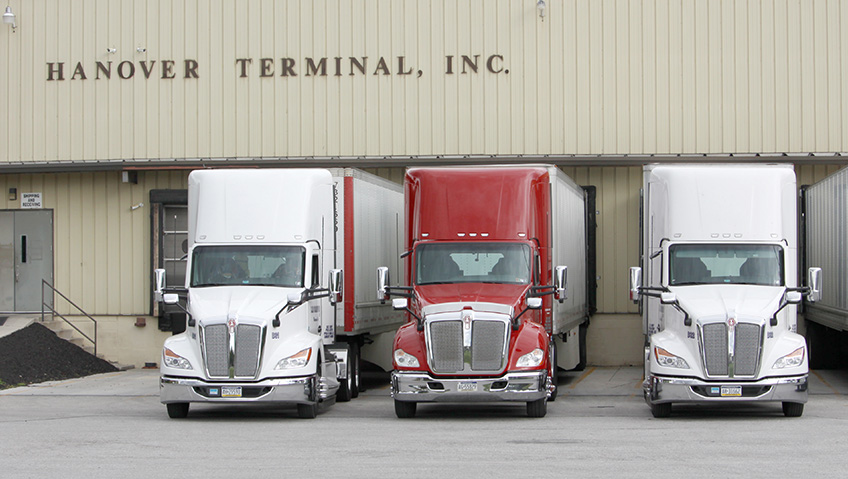The Central Pennsylvania-based Hanover Logistics Company consists of two core business aspects: Hanover Terminal Inc. represents warehousing management services, while R.H. Crawford Inc. (RHC) supports everything based in transportation. Together, they share over 150 years of service in the logistics industry. Currently, the two companies are composed of 140 trucks and 2 million square feet of owned warehouse space, and employ 200-plus employees.
Since we previously spoke in 2022, the last two-and-a-half years have brought consistent growth for Hanover Logistics. This growth is due to its considerable customer base on the warehousing side and is also related to the onboarding of new business. The Hanover Pennsylvania community and region have seen overall growth, too, as manufacturers and shippers in South Central Pennsylvania increase their supply holdings closer to manufacturing bases in the area while still providing ease of access to the busy Port of Baltimore. Hanover is within a one-day drive from 40 percent of the U.S. population and 60 percent of the Canadian population.
In response to its expansion, Hanover Logistics recently introduced its new building, on which construction began in early 2024 and was completed by year’s end. It is the first company build made with pre-cast concrete, boasting 82,000 square feet in total, seven docks and one drive-in, and ceiling heights of up to 38 feet. This site was last built on through the 1980s and ’90s as the business grew. With the growth trajectory of the company and area, founder and President Kurt Dietrich decided to move to the next phase of development of the site at 201 Center St. in Hanover with the construction of this new class A facility. Hanover Logistics Director of Operations, Charlie Fowler, says that the intention is to fully rack the space and to obtain height lift equipment to allow staff to easily add or remove stock. In an energy-conscious move, Hanover Logistics recently upgraded the lighting in all its facilities to LED lights as well. As Fowler explains, the move was done for the company to do its part for energy conservation.
The company also upgraded its equipment with a mix of electric forklifts, heavier weight dock levelers, and heavy weight lift trucks, which have improved its capabilities to support a wide variety of products, from roll stock paper to palletized consumer goods and raw materials for manufacturing.
The company’s position as a warehousing and logistics provider continues to provide advantages to its market. Hanover often handles the entire end-to-end supply chain for its clients, which in turn helps them better serve their clients and concentrate on other core business development strategies. “We work closely with our customers to provide a full-service supply chain partnership which is also a key differentiator in our business model,” the Director of Operations says. This includes managing e-commerce solutions for shippers and distributors, as well as traditional truck movement both in and out of state.
As an early adopter of e-commerce and pick-and-pack operations, Hanover has positioned itself as a uniquely capable and dependable provider. With its long-standing customer focused mindset, Hanover has helped its clients grow, creating organic growth for Hanover as well.
Beyond its customer-based services, the company’s dedication and appreciation for its workforce reinforces the people-first focus that is at the heart of the women- and family-owned business. The company proudly puts its people first and gives them leadership of their own teams and processes. This allows the workforce to take pride in their work, an attitude which is passed along to customers. Hanover’s facilities are supported by site-specific leadership who build their own team and benchmarks to incentivize the crew to find success and better serve customers.
Hanover maintains its own safety committee comprising key contributors from all different sites at every level of staff. The committee meets monthly for site walks to identify potential risks, which are efficiently submitted into work and repair orders and monthly reports to executive leadership for accountability. The team also participates in fun and engaging practices to encourage safety, where employees can win prizes each day without a documented safety incident. Similar incentives are available to drivers on the trucking side, with bonuses awarded for safe miles driven and for passing Department of Transportation inspections. “Our people, safety, and customers are our highest priorities,” Fowler adds.
Employees’ health and wellness is also paramount, with the goal of supporting employees in healthy lifestyle choices, whether through offering a new fitness center to staff and their families or by featuring group health insurance benefits that encourage regular wellness appointments. Hanover Logistics stays at the forefront of both safety and service by hiring and continually training a skilled workforce, offering competitive compensation, and providing work that fits team members’ unique lifestyles. Hanover wants its employees to enjoy coming to work feeling appreciated and to aspire to be good teammates.
The leadership team is always eager to support and celebrate the success of its workforce, which garnered several awards in 2024 for their hard work in trucking collectively and individually. These include Safe Driver competitions where the company’s safest drivers compete with other national trucking companies in various driving, written, and pre-check competitions. RHC’s drivers and team have scored top awards and have supported the first-place finishers in competing at the national level. And Food Logistics has named Hanover Logistics to its top 3PL & Cold Storage Providers List year after year. The company has also updated its facilities’ food grade certifications to BRCGS accreditation.
During our last feature, Hanover Logistics was still in adaptation mode following the COVID-19 pandemic, the effects of which were still being dealt with worldwide. While the company has made its way out of the tumultuous time, the pandemic highlighted potential flaws in the just-in-time shipping approach because manufacturers had a hard time getting materials from overseas; as a result, more businesses began to think about holding raw materials closer to manufacturing hubs to avoid it getting bottlenecked in transit.
This trend away from the just-in-time model will likely persist as Hanover Logistics navigates other industry challenges. According to Hanover’s Director of Logistics, Kevin Davis, space availability will be a big priority going into 2025, as warehouse and storage space will be tight in certain markets while abundant in other areas. Over the last couple of years, he notes that there has been a big push to build more warehouses, leading to a flood in the market. The continuation of this push will depend on location and what the state of importing will look like over the next four years of the new administration.
Davis believes that automation will continue to find a stronger foothold within the logistics industry as well, with new manufacturing buildings and factories being constructed with automation in mind for the long term. While many within these spaces are a bit leery of fully embracing it, several manufacturing outfits in Hanover, Pennsylvania are resilient (especially considering that Hanover is considered the snack food capital of the world) to changing economies, so the region is in a good position to retain its high occupancy rating even amongst potentially disruptive market shifts and trends.
Trucking, Davis says, has been a bit depressed in the last few years as a decline in freight demand coupled with higher interest rates is slowing the trucking economy. Hanover Logistics hopes to see more of an increase going forward; if anything, trucking is seeing a rebalancing after a large post-COVID spike, so things should level off to a more typical volume in time, he believes.
The years to come will see Hanover Logistics continue to grow its presence in warehousing with the support of its transportation arm, investigating potential opportunities outside of the Hanover region. The company aims to grow in a smart and measured way. “We plan to work with our key customers in pursuit of that growth and in regions that we see opportunity,” Davis concludes. We look forward to seeing where that growth takes the company next.






